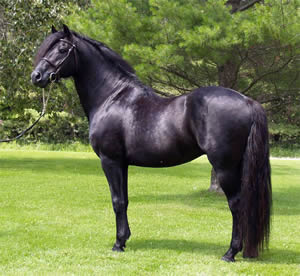History
The Canadian Horse descended from the French stock Louis XIV sent to Canada in the late 17th century. His goal was to develop a breeding program in the colony, but only 2 stallions and 12 mares survived the difficult sea journey made in 1665. Louis sent two more shipments, bringing the total number of horses to more than 40. Most were Breton or Norman in breeding, but some included Andalusian blood.
The horses were leased to farmers for money or in exchange for a foal (although they remained the property of the king for three years). In 1679, there were 145 horses. In 1696, the number of horses in the colony had tripled. The Friesian blood was added to the French-Canadian horses in the late 17th and early 18th century, adding trotting ability and feathering to the legs. Breeders bred different types to meet the individual needs (one type was the Canadian Pacer.
The horses thrived despite the harsh conditions, including little food, poor shelter, hard work, and bad roads. Many of the horses were exported to the West Indies and the USA, influencing the breeds in those areas.
In the early 19th century, thousands of horses were exported to America, who needed to meet the growing demand for roadsters. Unfortunately, this lead to a drop of the breed in Canada in the 1870s, and the stud book was opened in 1886 to preserve the breed and prevent possible extinction. The Canadian Horse Breeders' Association was formed in 1895. Soon, the numbers increased.
Behavior
They are hardy horses and easy keepers. Today, most Canadian horses are used as riding and driving horses, and are known for their jumping ability. They are seen in competition in almost every discipline, as well as for leisure riding.
Function
The Canadian horse is a common animal symbol of Canada. In 1909, the Canadian Parliament declared it the national breed of the country, and in 2002 was made an official animal symbol of Canada by Parliamentary Act. In 2010, the provincial legislature of Quebec named it a heritage breed of the province.
most Canadian horses are used as riding and driving horses, and are known for their jumping ability. They are seen in competition in almost every discipline, as well as for leisure riding. They can also be found in light draft work, trail riding, and working as a stock horse.






